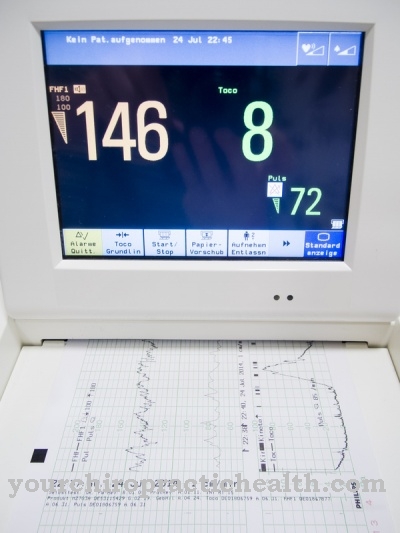In the Bone marrow transplant bone marrow and thus stem cells are transferred to restore regular blood formation. Bone marrow transplantation is usually indicated if the blood-forming cell system has been severely impaired as a result of a tumor disease or previous therapy (especially high-dose chemotherapy).
What is a bone marrow transplant?

As Bone marrow transplant (BMT for short) is the name given to the replacement of damaged blood-forming bone marrow (medulla ossium) with healthy bone marrow cells, which can usually be necessary after malignant tumor diseases and / or high-dose chemotherapy or radiation therapy.
In general, a distinction is made between an autologous, in which the transplanted bone marrow material comes from the person to be transplanted (self-donation), and an allogeneic bone marrow transplant, which is used in most cases and in which the donor and recipient are not the same person (external donation) .
Ideally, what is known as an isologous bone marrow transplant can be carried out, which is characterized in that the cells to be transplanted come from a twin of the person concerned.
Function, effect & goals
Generally one is Bone marrow transplant always necessary when the bone marrow, in which all blood cells are formed, is so damaged by diseases or certain therapeutic measures that it can no longer fulfill this function.
Significant impairment of bone marrow function can primarily result in malignant tumors such as lymphomas (lymph gland cancer) or leukemia (blood cancer) as well as solid tumor diseases. Pronounced autoimmune diseases that lead to the destruction of the body's own structures as a result of a dysregulated immune system can also make a bone marrow transplant necessary. In addition, high-dose chemotherapy or radiation therapy measures have an increased risk of damage to the bone marrow.
In the run-up to the bone marrow transplant, the blood and urine values are usually analyzed, the thorax (chest) x-rayed, the abdomen and heart examined by sonography, and an EKG (electrocardiogram) and EEG (electroencephalography) performed to measure the brain waves. In addition, a lung function test and possibly a computed tomography are common. In many cases, a bone marrow puncture is used to take a tissue sample and check whether certain tissue characteristics such as human leukocyte antigens (HLA) match.
Before replacing the damaged bone marrow, it should be completely destroyed, particularly in the case of malignant tumor diseases, in order to avoid recurrences. As a rule, this is achieved through high-dose chemotherapy with cytostatics or through a combination of chemotherapy and radiation therapy measures. Following this pre-treatment, known as conditioning, which lasts four to ten days on average, the bone marrow transplant takes place.
In the context of allogeneic bone marrow transplantation, the bone marrow material is obtained from the bone marrow or the bone marrow stem cells from the blood of the donor (peripheral stem cell removal) and then infused into the recipient's blood system via a vein. The infused healthy bone marrow cells enter the bone marrow via the blood system, settle and divide. If the therapy is successful, the newly settled bone marrow cells begin to synthesize blood cells independently after a few weeks.
An autologous bone marrow transplant (own marrow donation) is usually used when no suitable donor can be found. For this purpose, in a remission phase without the formation of new tumor cells, the patient's own bone marrow is removed, processed and then frozen. Following the chemotherapy and radiation therapy pretreatment, the patient's own bone marrow is returned to the patient.
Risks, side effects & dangers
A Bone marrow transplant is a very stressful and serious surgical procedure that can lead to life-threatening complications. Correspondingly, a bone marrow transplant is usually only carried out when all treatment alternatives have been exhausted and there is a life-threatening underlying disease with good prospects of recovery from the operation.
A variety of complications can arise during the surgical procedure. For example, in rare cases, the transplanted bone marrow cells do not settle in the recipient's bone marrow. In some cases, the transplanted cells mark tissue structures of the recipient as foreign and attack it. The skin, liver and / or intestines of the recipient are particularly affected. The reaction can, however, be controlled with medication using immunosuppressants and, if necessary, counteracted in the event of overreactions.
In addition, the risk of infectious diseases is greatly increased in the first three months after the surgical procedure, during which the blood and immune systems are rebuilt, and even a simple cold can be life-threatening for those affected. As a result of the chemotherapeutic pretreatment, the immunological knowledge of the defense system is destroyed, so that it has to be re-acquired.
Vaccinations against tetanus, diphtheria or polio must be repeated accordingly. In addition, there is only a small risk for the donor in the case of a bone marrow transplant, which is derived from the usual dangers associated with anesthesia.





.jpg)







.jpg)

.jpg)
.jpg)











.jpg)